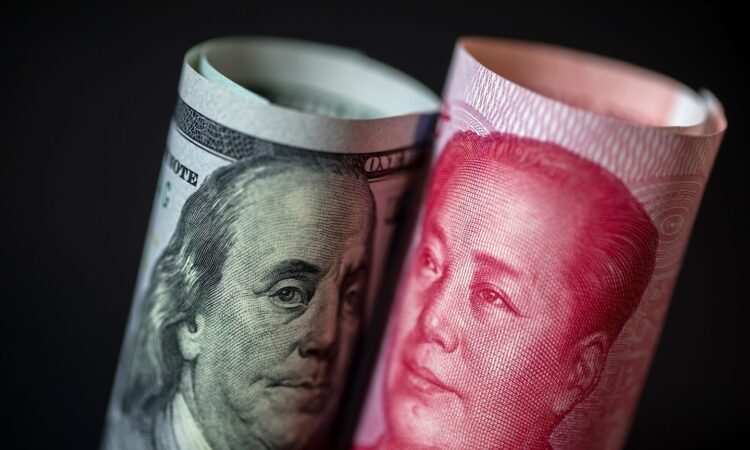
Later this week BRICS foreign ministers will gather in Cape Town, South Africa along with representatives from other countries such as Saudi Arabia, the United Arab Emirates and Kazakhstan. It’s the warm-up act for the main event, with heads of state scheduled to meet in late August in Johannesburg, though the location may be switched to allow Russian President Vladimir Putin to attend without risking arrest under a warrant from the International Criminal Court. There’s not much moral high ground in sight, which defines the nature of the gatherings — an ill-disguised attempt to overthrow the post-World War II rules-based world order.
Following its invasion of Ukraine, $300 billion worth of Russian foreign exchange and gold reserves were frozen by the US and Europe, raising the possibility that the overseas assets of countries acting contrary to western interests could similarly be withheld. There is a point here about potential overreach, as western sanctions on bad state actors have mushroomed in recent years. The US government cannot ignore the fallout from its retaliatory action against Putin, and enlightened self interest suggests it should deliver more clarity on what it will and won’t do in the future. The irony is that de-dollarization is rearing its head just as the US settles its debt-ceiling fracas.
The influence of the BRICS coalition could be substantial, given the group has 42% of the world’s population. But economically, it delivers just 23% of total global output and only 18% of trade. According to the Society for Worldwide Interbank Financial Transactions, the dollar is used for 42% of currency transactions. The euro’s share is 32% but it doesn’t have anything like the same influence outside Europe and parts of North Africa. The Chinese yuan contributes about 2%, as its non-domestic usage does not extend significantly even within Asia, or outside of trade-linked finance.
The defining element for a reserve currency is where it is the second-most used currency for domestic transactions. The dollar is pretty much the most-utilized method of exchange across the world after each nation’s own currency — sometimes even surpassing domestic currencies. Almost every commodity, including oil and gold, trades in dollars. Even crypto-currencies are paired almost exclusively with the greenback. What is also vital for a reserve currency is its use as a store of value. The International Monetary Fund estimates 59% of global central bank reserves are in dollars, with euros at 20%, and the yuan just 5%.
As many as 19 other countries are interested in joining the federation, Bloomberg News reported, with 13 nations already formally invited. But an ever bigger set of contradictory interests will only make the concept even less manageable. A common currency is on the agenda. One Russian idea is to make it part-backed by gold — although moving gold bars around is no simple matter. Despite a mutual dislike of the extended reach of the US Treasury’s Office of Foreign Assets Control, the grouping’s fundamental differences are too wide for it to make headway. Cheap Russian oil may currently be highly attractive for hydrocarbon-importing nations but it is not a long-term foundation for world trade.
South African Reserve Bank Governor Lesetja Kganyago highlighted last month that any legal BRICS-backed tender would require a single central bank. As with its belt-and-road initiative across Asia into Europe, it is impossible to imagine that China would not dominate any wider BRICS forum, making Shanghai the most likely location for a BRICS central bank. That is unlikely to sit easily with India, which frequently has border skirmishes with China. Replacing a liberal democracy-backed currency with a concept dominated by a totalitarian state with capital controls won’t float.
If the Organization of the Petroleum Exporting Countries cannot come up with a petro-currency, what chance does a random bunch of geographically disparate nations have? A South American trade currency concept called the “sur” is struggling because smaller countries’ interests will just be smothered by the much larger economy of Brazil.
Some BRICS countries are resource-rich, most resource-poor. None, either alone or combined, can magic up an alternative currency. Substantive progress on nuts-and-bolts commerce among the group has to come first. The dollar’s dominance might be irksome but there is no alternative that is anywhere near critical mass. Rage against the dollar machine all you want — but it isn’t listening.
More From Bloomberg Opinion:
• Mighty Dollar Can Fight Off the Digital Upstarts: Andy Mukherjee
• What Xi Jinping Wants in Latin America: Eduardo Porter
• The Dollar May Decline, Gradually Not Suddenly: Niall Ferguson
This column does not necessarily reflect the opinion of the editorial board or Bloomberg LP and its owners.
Marcus Ashworth is a Bloomberg Opinion columnist covering European markets. Previously, he was chief markets strategist for Haitong Securities in London.
More stories like this are available on bloomberg.com/opinion



